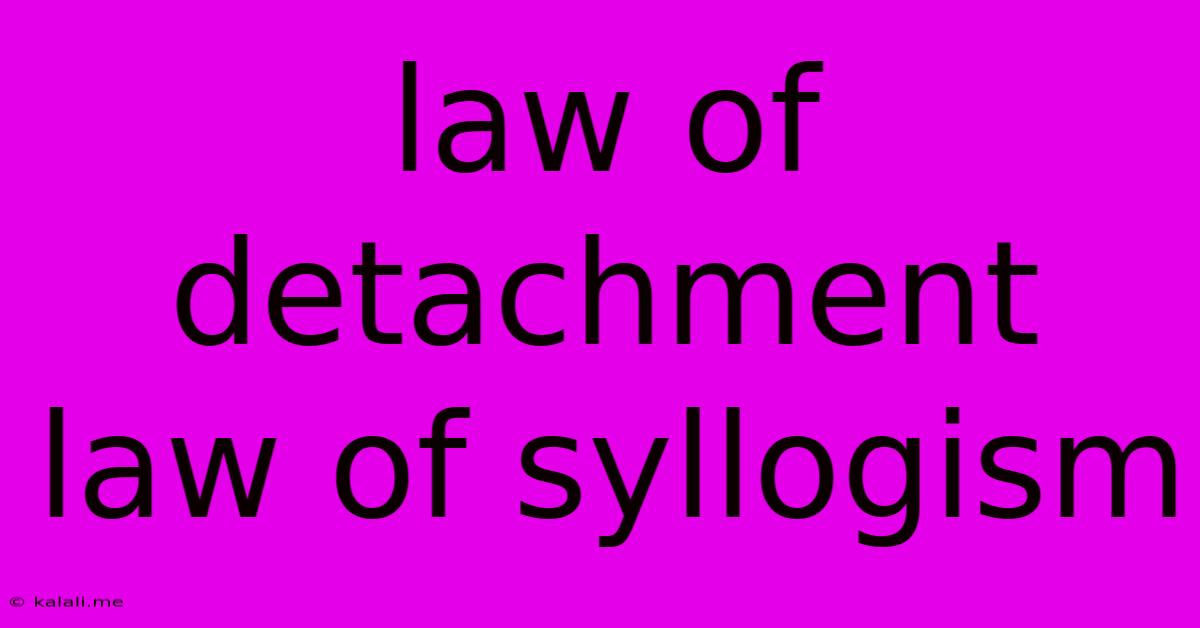Law Of Detachment Law Of Syllogism
Kalali
May 09, 2025 · 3 min read

Table of Contents
Detachment and Syllogism: Two Pillars of Logical Reasoning
This article explores two fundamental concepts in logic: the Law of Detachment (also known as Modus Ponens) and the Law of Syllogism. Understanding these laws is crucial for building sound arguments and evaluating the validity of reasoning in various fields, from mathematics and philosophy to everyday decision-making. We'll delve into their definitions, provide illustrative examples, and highlight their practical applications.
What is the Law of Detachment (Modus Ponens)?
The Law of Detachment is a fundamental rule of inference in propositional logic. It states that if we have a conditional statement "If P, then Q" (represented as P → Q), and we know that P is true, then we can conclude that Q is also true. In simpler terms, if the hypothesis (P) is true, then the conclusion (Q) must also be true.
-
Formal Representation:
P → Q P Therefore, Q
-
Example:
"If it's raining (P), then the ground is wet (Q)." "It's raining (P)." "Therefore, the ground is wet (Q)."
This is a straightforward and intuitively obvious example. The Law of Detachment provides a solid basis for deductive reasoning – drawing conclusions from established premises.
Applications of the Law of Detachment:
The Law of Detachment finds applications in numerous fields:
- Mathematics: Proving theorems often involves applying the Law of Detachment to previously established lemmas and axioms.
- Computer Science: Programming logic and algorithm design heavily rely on conditional statements, where the Law of Detachment governs the flow of execution.
- Everyday Life: Many of our everyday decisions are based on implicit applications of the Law of Detachment. For example, "If I study hard (P), then I'll get a good grade (Q)." If you study hard (P), you expect a good grade (Q).
What is the Law of Syllogism?
The Law of Syllogism deals with chaining together conditional statements. It states that if we have two conditional statements of the form "If P, then Q" and "If Q, then R," then we can conclude "If P, then R." Essentially, we can link the premises to deduce a new conditional statement.
-
Formal Representation:
P → Q Q → R Therefore, P → R
-
Example:
"If it's snowing (P), then the roads are icy (Q)." "If the roads are icy (Q), then driving is dangerous (R)." "Therefore, if it's snowing (P), then driving is dangerous (R)."
Here, we've combined two conditional statements to reach a new conclusion. Note that we haven't necessarily established that it is snowing; we've only established a new conditional relationship.
Applications of the Law of Syllogism:
The Law of Syllogism is a powerful tool for:
- Chain Reasoning: Building complex arguments by connecting multiple conditional statements.
- Legal Reasoning: Constructing legal arguments based on established precedents and statutes.
- Scientific Inquiry: Drawing conclusions based on interconnected hypotheses and observations.
Distinguishing Between Detachment and Syllogism:
The key difference lies in their conclusions. The Law of Detachment draws a direct conclusion about the truth of a statement (Q), given the truth of another (P). The Law of Syllogism, however, creates a new conditional statement (P → R) linking the initial premises.
Conclusion:
The Law of Detachment and the Law of Syllogism are fundamental tools for logical reasoning, offering frameworks for constructing valid arguments and evaluating the validity of inferences. Understanding these laws is essential for critical thinking and problem-solving in various aspects of life. By mastering these concepts, you can enhance your analytical skills and build more robust and persuasive arguments.
Latest Posts
Latest Posts
-
How Do The Bases Bond Together A Bonds With
May 09, 2025
-
What Is A 8 Out Of 10 Percentage
May 09, 2025
-
How Do Orchids Adapt To The Tropical Rainforest
May 09, 2025
-
What Is 2 5 In Fraction Form
May 09, 2025
-
How Much Is 2 3 Of A Cup In Ounces
May 09, 2025
Related Post
Thank you for visiting our website which covers about Law Of Detachment Law Of Syllogism . We hope the information provided has been useful to you. Feel free to contact us if you have any questions or need further assistance. See you next time and don't miss to bookmark.